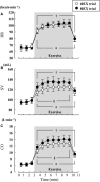Enhanced muscle pump during mild dynamic leg exercise inhibits sympathetic vasomotor outflow
- PMID: 25347854
- PMCID: PMC4187562
- DOI: 10.14814/phy2.12070
Enhanced muscle pump during mild dynamic leg exercise inhibits sympathetic vasomotor outflow
Abstract
Muscle sympathetic nerve activity (MSNA) is not increased during leg cycling at light and mild intensities, despite activation of central command and the exercise pressor reflex. We determined whether increasing central blood volume and loading the cardiopulmonary baroreceptors modulate sympathetic vasomotor outflow during leg cycling. To this end, we changed the pedaling frequency to enhance skeletal muscle pump. Subjects performed two leg cycle exercises at differential pedal rates of 60 and 80 rpm (60EX and 80EX trials) for two conditions (with and without MSNA measurement). In each trial, subjects completed leg cycling with a differential workload to maintain constant oxygen consumption (VO2). MSNA was recorded via microneurography at the right median nerve of the elbow. Without MSNA measurement, thoracic impedance, stroke volume (SV), and cardiac output (CO) were measured non-invasively using impedance cardiography. Heart rate and VO2 during exercise did not differ between the 60EX and 80EX trials. Changes in thoracic impedance, SV, and CO during the 80EX trial were greater than during the 60EX trial. MSNA during the 60EX trial was unchanged compared with that at rest (25.8 ± 3.1 [rest] to 28.3 ± 3.4 [exercise] bursts/min), whereas a significant decrease in MSNA was observed during the 80EX trial (25.8 ± 2.8 [rest] to 19.7 ± 2.0 [exercise] bursts/min). These results suggest that a muscle pump-induced increase in central blood volume, and thereby loading of cardiopulmonary baroreceptors, could inhibit sympathetic vasomotor outflow during mild dynamic leg exercise, despite activation of central command and the exercise pressor reflex.
Keywords: cardiopulmonary baroreceptors; dynamic leg exercise; sympathetic activity.
© 2014 The Authors. Physiological Reports published by Wiley Periodicals, Inc. on behalf of the American Physiological Society and The Physiological Society.
Figures




Similar articles
-
Hypoxia attenuates cardiopulmonary reflex control of sympathetic nerve activity during mild dynamic leg exercise.Exp Physiol. 2016 Mar;101(3):377-86. doi: 10.1113/EP085632. Epub 2016 Jan 28. Exp Physiol. 2016. PMID: 27094223
-
Sympathetic vasomotor outflow during low-intensity leg cycling in healthy older males.Exp Physiol. 2022 Aug;107(8):825-833. doi: 10.1113/EP090497. Epub 2022 Jul 4. Exp Physiol. 2022. PMID: 35749656
-
Respiratory modulation of sympathetic vasomotor outflow during graded leg cycling.J Appl Physiol (1985). 2021 Aug 1;131(2):858-867. doi: 10.1152/japplphysiol.00118.2021. Epub 2021 Jul 1. J Appl Physiol (1985). 2021. PMID: 34197231
-
Muscle sympathetic nerve activity during exercise.J Physiol Sci. 2019 Jul;69(4):589-598. doi: 10.1007/s12576-019-00669-6. Epub 2019 May 3. J Physiol Sci. 2019. PMID: 31054082 Free PMC article. Review.
-
Regulation of muscle sympathetic nerve activity during exercise in humans.Exerc Sport Sci Rev. 1991;19:313-49. Exerc Sport Sci Rev. 1991. PMID: 1936089 Review.
Cited by
-
Exercise intensity modulates brachial artery retrograde blood flow and shear rate during leg cycling in hypoxia.Physiol Rep. 2015 Jun;3(6):e12423. doi: 10.14814/phy2.12423. Physiol Rep. 2015. PMID: 26038470 Free PMC article.
-
Differential contributions of cardiac, coronary and pulmonary artery vagal mechanoreceptors to reflex control of the circulation.J Physiol. 2022 Sep;600(18):4069-4087. doi: 10.1113/JP282305. Epub 2022 Aug 29. J Physiol. 2022. PMID: 35903901 Free PMC article. Review.
-
Effects of dynamic arm and leg exercise on muscle sympathetic nerve activity and vascular conductance in the inactive leg.J Appl Physiol (1985). 2019 Aug 1;127(2):464-472. doi: 10.1152/japplphysiol.00997.2018. Epub 2019 Jun 27. J Appl Physiol (1985). 2019. PMID: 31246555 Free PMC article.
-
Effects of local vibration stimulation on muscle recovery and hypertrophy.J Phys Ther Sci. 2024 Aug;36(8):441-446. doi: 10.1589/jpts.36.441. Epub 2024 Aug 1. J Phys Ther Sci. 2024. PMID: 39092417 Free PMC article.
-
Response to Letter to Editor - Comments on: Sympathetic vasomotor outflow during low-intensity leg cycling in healthy older males.Exp Physiol. 2023 Feb;108(2):320-322. doi: 10.1113/EP091030. Epub 2023 Jan 12. Exp Physiol. 2023. PMID: 36634155 Free PMC article. No abstract available.
References
-
- Adreani C. M., Hill J. M., Kaufman M. P. 1997. Responses of group III and IV muscle afferents to dynamic exercise. J. Appl. Physiol.; 82:1811-1817. - PubMed
-
- Badeer H. S. 1981. Cardiac output and venous return as interdependent and independent variables. Cardiology; 67:65-72. - PubMed
-
- Borg G. A. V. 1982. Psychophysical bases of perceived exertion. Med. Sci. Sports Exerc.; 14:377-381. - PubMed
-
- Boushel R. 2010. Muscle metaboreflex control of the circulation during exercise. Acta Physiol. (Oxf.); 199:367-383. - PubMed
-
- Cai Y., Holm S., Jenstrup M., Stromstad M., Eigtved A., Warberg J. 2000. Electrical admittance for filling of the heart during lower body negative pressure in humans. J. Appl. Physiol.; 89:1569-1576. - PubMed
LinkOut - more resources
Full Text Sources
Other Literature Sources

